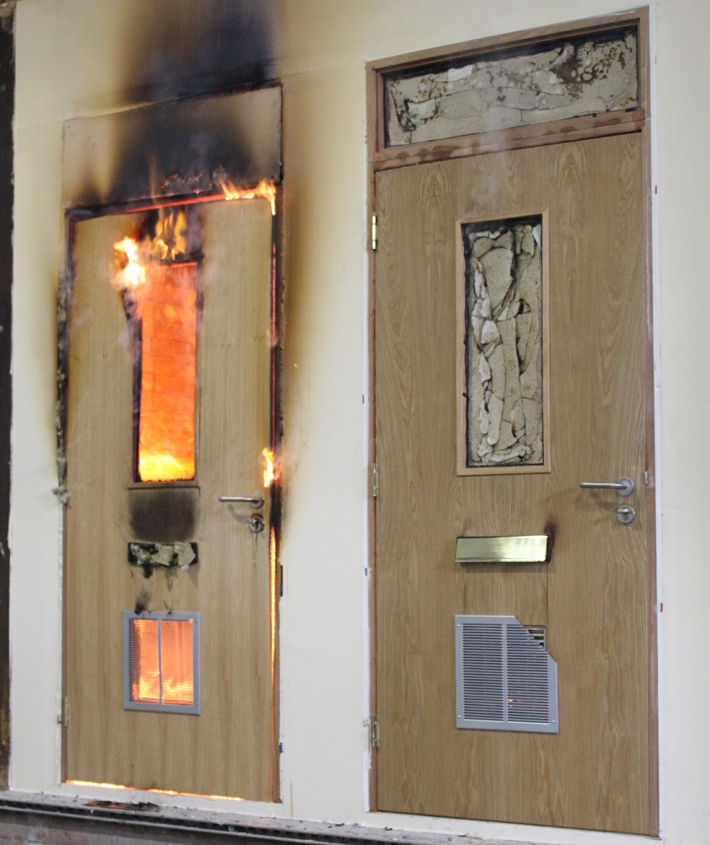YOU will have, no doubt, already been in and out of them today, but probably haven’t given them the attention they deserve, say commercial property agent Prop-Search, although they have silently been protecting you. But what are they? Fire doors.
Fire doors form an important part of the fire safety precautions built into the majority of commercial building which, along with alarms, lighting, elements of the buildings structure and signage, sit waiting to protect us when required. Whilst often overlooked, they have recently been celebrated during the recent Fire Door Safety Week – promoted by the British Woodworking Federation and Fire Door Inspection Scheme (FDIS) – with the intention of raising awareness of the critical role they play.
Samantha Jones, an Associate Director at Prop-Search, said: “Whilst we all clearly remember the harrowing events of the Grenfell Tower disaster a few months ago, how many businesses have recently checked their own fire protection? Along with the routine maintenance of fire extinguishers, checking fire doors should also be part of a regular fire risk assessment, which should also examine all aspects of fire safety management.”
Many people do not realise that the real job of a fire door is to hold back not just fire, but smoke and toxic gases; delaying the spread around a building and keeping the vital means of escape route clear. They only work properly if they are specified, manufactured, installed and maintained correctly, and of course, closed when a fire breaks out.
A correctly fitted, good-quality fire door and frame can contain a fire for 30 minutes or more, giving time for alarms to sound and people to safely leave the building. Fire Door Safety Week highlighted issues of poor installation and maintenance to encourage building owners and users to check the operation and condition of their doors.
There is an easy Five Step Fire Door Check that anyone can do:
* Check for certification. Is there a label or plug top (or occasionally on the side) of the door to show it is a certificated fire door?
* Check the gaps. The gaps around the top and sides of the door should be consistently less than 4mm when closed. For guidance, a £1 coin is about 3mm thick. The gap under the door can be slightly larger – up to 8mm is not uncommon – but it does depend on the door. As a rule of thumb, if you can see light under the door, the gap is likely to be too big. If the gaps are too big smoke and fire could travel through the cracks.
* Check the seals. Doors have smoke seals to prevent cold smoke passing around the edge of the door. These smoke seals can be rubber strips or brush seals around the perimeter of the door that completely seal the gap between the closed door and frame. Doors may also have intumescent seals – normally white or brown plastic looking strips – set into the edge of the door or frame that when exposed to heat swell up to seal the gap between the door and frame. Both types of seal should be intact with no sign of damage. These seals are vital to ensure fire and smoke can’t move through the gaps.
* Check the hinges. Hinges should be firmly fixed – a modern fire door has three or more of them – with no missing or broken screws.
* Check the door closes properly. If the door is opened about halfway, let go and allow it to close by itself – it should close firmly onto the latch. A fire door only works when it is closed and should not be propped open.
Alarmingly statistics published by Fire Door Safety Week from fire door inspections of 31 sites (677 doors) identified 2,506 faults. The most common faults were:
* Over 61 per cent had fire or smoke seals either missing, installed incorrectly or not filling perimeter gaps correctly
* Over a third has incorrect signage
* More than 230 (34 per cent) has excessive gaps between the door and its frame
* Over 15 per cent had damage to the door leaf
* Almost one in five had unsuitable hinges
Samantha Jones concluded: “Hopefully we will all be encouraged to pay more attention to fire doors, whether as a business owner, member of staff or in a public building, and take the time to report when something’s wrong. This will enable early and appropriate action to be taken, which importantly should make everyone a little safer.”
Prop-Search can review fire safety provisions when preparing building surveys for building purchasers and in planning property maintenance. Further information or advice can be obtained from Prop-Search on 01933 223300 or 01604 492000 or at the website www.prop-search.com


